
ISSN: 3005-8198 (online) / 3005-818X (print)
Volume 2, Issue 1 (January – March 2024), pp: 1-7
![]()
Studying Effect of Saturation Degree on the Bearing Capacity and Failure Mechanism of Sandy Soils
Sanaa Khalil 1,a*, Nazih Abboud 1,b, Firas Almoukdad 1,c
1Department of Geotechnical Engineering, College of Civil Engineering, Damascus University, Damascus, Syria.
E-mail: sanaa.khalil@damascusuniversity.edu.sy a,*, nazihabbud026@gmail.com b, dr.f-Moukdad@outlook.com c
Received: 03 January 2024 | Revised: 13 February 2024 | Accepted: 06 March 2024 | Published: 26 March 2024
In this research, an experimental method was employed on samples of sandy soils from the Tartous and Palmyra regions. The objective was to investigate the impact of saturation degree on the bearing capacity of partially saturated sandy soil and the associated failure mechanism. To achieve the aim of the research, a series of tests were conducted to determine the basic physical properties of the soils. Additionally, a series of laboratory loading tests were conducted for a footing model atop sandy soil under various saturation degrees. Matric suction was measured, and soil water characteristic curves were determined using the filter paper technique. The results were subjected to analysis and discussion, and the experimental work demonstrated that saturation degree had a clear effect on the bearing capacity. It was observed that the bearing capacity of partially saturated soil is higher than that of fully saturated soil. The values of the increase were found to range between 2.3 and 9.7 times the bearing capacity in the fully saturated state. An empirical relationship was proposed to simulate the bearing capacity of partially saturated sandy soil based on the experimental results. Furthermore, the results indicated that the saturation degree exerted a discernible influence on the failure mechanism. In particular, a failure mode associated with dense soils was discerned in medium-dense soils at specific degrees of saturation for the tested soils.
Keywords: Bearing Capacity; Sandy Soil; Saturation Degree; Failure Mechanism; Footing.
The conventional approach to foundation design is based on soil mechanics theories that assume the soil is in a state of complete saturation, which represents the most unfavorable mechanical condition. However, this condition is rarely reached in practice. In reality, natural soil is frequently only partially saturated, particularly at the depths at which surface foundations are typically placed. When theories that assume complete saturation are applied to partially saturated soil, the resulting values for soil bearing capacity are often implausible, leading to an uneconomical foundation design.
Soils that are saturated are typically described as having two phases: solid particles and water. Partially saturated soils, on the other hand, exhibit two additional phases: air and water-air interface which acts as a thin elastic film and significantly influences the mechanical behaviour of the soil (Li, 2009). The properties of the water-air interface differ from those of ordinary water, and it has a molecular structure similar to that of ice (Matsumoto & Kataoka, 1988). The presence of air and water within the pores of soils gives rise to two distinct forms of pore pressure: air pressure and water pressure, the latter of which is negative due to the influence of surface tension forces. The disparity between air and water pressure is referred to as matric suction, and Kelvin’s equation provides a mathematical representation of this phenomenon (Rameriz, 2013):
ua_uw= 2Ts/R (1)
Ts: surface tension, R: radius of curvature of the meniscus, ua – uw: matric suction.
The matric suction in partially saturated soils is subject to change in accordance with the degree of saturation. These changes result in the formation of distinct areas of saturation, which can be determined by a Soil Water Characteristic Curve (SWCC) (Vanapalli et al., 1999). This is a useful tool for the determination of the properties of partially saturated soils, including shear strength and permeability coefficient. The experimental determination of these properties is both costly and time-consuming (Sheikhtaheri, 2014).
Matric suction has been demonstrated to exert a significant influence on shear strength (Zainal & Fadhil, 2018; Vanapalli et al., 1996), which, in turn, exerts a notable impact on the bearing capacity of the soil.
Field load plate tests were conducted to study the effect of matric suction on the behaviour of partially saturated lateritic soils. The results of the field tests demonstrated that a minor increase in matric suction resulted in a notable enhancement in bearing capacity (Costa et al., 2003). Similar results were obtained by Mohamed and Vanapalli (2012), who conducted several field loading tests on poor sand to elucidate the effect of matric suction on the bearing capacity of the sandy soil. The results of the tests demonstrated a distinct increase in the bearing capacity of the bearing plate due to the contribution of matric suction (Mohamed & Vanapalli, 2012). Ajdari and Pour (2015) conducted a series of loading tests on circular footing models resting on unsaturated sandy soil. Their findings indicated that designing footings based on the water table at its highest level may not be the most optimal approach (Ajdari & Pour, 2015). Nyuin et al., (2016) demonstrated that an increase in matric suction resulted in a corresponding increase in bearing capacity. This was evidenced by a series of tests conducted on a square footing model on partially saturated sandy soil, which revealed that the largest increase in bearing capacity occurred at matric suction equal to the residual value, which is approximately four times the bearing capacity in the state of full saturation (Nyuin et al., 2016). It is considered that the contribution of matric suction to the bearing capacity of partially saturated soils is equivalent to the effect of reinforcement in reinforced concrete design (Al Qayssi, 2018). In a study conducted by Safarzadeh and Aminfar (2019), the effect of lowering the water level on the bearing capacity of a foundation on compacted sand was investigated through the implementation of several laboratory loading tests at varying water levels. The findings revealed that reducing the water level resulted in an increase in matric suction, leading to a nonlinear enhancement in the ultimate bearing capacity, reaching up to fourfold the value observed in the fully saturated condition (Safarzadeh & Aminfar, 2019). Du et al., (2021) put forth a methodology based on the discretisation technique in finite analysis to ascertain the bearing capacity of footings on partially saturated soils. This approach considers alterations in soil parameters associated with matric suction (Du et al., 2021).
It is therefore important to study the effect of the degree of saturation on the properties of sandy soil, which is related to the design calculations for foundations. The objective of this research is to investigate the influence of saturation degree on the bearing capacity and failure mechanism of sandy soils. Based on the experimental findings, an empirical relationship is proposed to predict the bearing capacity of partially saturated soil.
The study employed fine-grained sandy soil classified as SP according to the Unified Soil Classification Scheme (USCS), sourced from two distinct locations (Tartous – Palmyra).
The grain size distribution of the soil is illustrated in Figure 1, and some of its fundamental physical properties are presented in Table 1.
Table 1. Summary of Properties for Tested Soils.
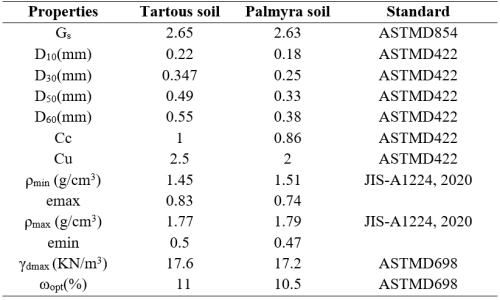
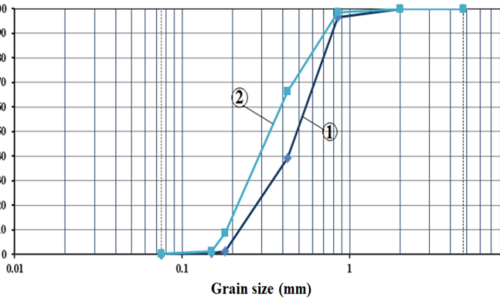
Figure 1. Particle Size Distribution Curves: 1. Tartous Soil, 2. Palmyra Soil.
Tests were conducted on a square footing comprising a steel plate, 50mm by 50mm with a thickness of 10mm, positioned on sandy soil within a square tank measuring 390mm by 390mm, 200mm in height and 5mm in thickness. Parallel horizontal lines were drawn inside the test tank in order to facilitate the control of the compaction of each layer with the specified density. A metal plate with dimensions of (390×390) mm and a thickness of 5 mm, which was pierced with four symmetrical holes, was employed during the compaction of the soil layers. The experimental setup employed for laboratory loading tests is illustrated in Figures 2 and 3.

Figure 2. Experimental Setup for Laboratory Loading Tests.
1.Electronic load cell, 2. Footing model, 3. Vertical deformation gauge, 4. Soil tank, 5. Partially saturated soil, 6. Vertical displacement gauge, 7. Hydraulic crane, 8. Control panel

Figure 3. Bearing Capacity Test Device.
The samples were prepared by mixing specific proportions of dry soil and water in order to achieve the requisite degrees of saturation. The quantity of water was determined using the equation proposed by Zainal (2018), which is based on the following percentages: 20, 25, 35, 50, 70, and 90.
S. e = Gs. ω (2)
S: Saturation Degree, e: Void Ratio, Gs: Specific Gravity, ω: Moisture
The soil was prepared with a medium relative density (dry density = 1.6 g/cm³), and specific proportions of dry sand were mixed with water by hand. The mixture was then covered with an airtight insulation cover and left for 48 hours until the moisture was homogeneous.
Subsequently, the soil was formed in the soil tank in four layers, with each layer measuring 45 mm in thickness. The requisite relative density was achieved by subjecting the material to a series of compressive forces applied to a compacting plate.
The contact filter paper method was employed to ascertain matric suction in accordance with ASTM D5298. The underlying principle of this method is that when a wet sample is placed in contact with a dry filter paper within an airtight container, the filter paper will absorb water from the soil until equilibrium of matric suction is reached. Tests were conducted at varying degrees of saturation (10%, 20%, 25%, 35%, 50%, 60%, 70%, 80%, and 90%), where specific percentages of dry soil were mixed with water, then covered with an airtight insulation cover and left for 48 hours until the moisture was homogeneous. The wet samples were formed in a glass container with the required volumetric weight and divided into two equal parts, with the filter paper placed in the middle of each sample. The Schleicher & Schuell No. 589 filter paper, with a diameter of 5.5 cm, was utilised in conjunction with two filter papers of 7 cm diameter, the 5,5cm diameter filter paper was placed between the aforementioned filter paper in order to prevent the former from becoming clogged by soil particles. Following this, the glass container was tightly closed and placed in an isolation container for a period of one week, during which time the matric suction was allowed to reach equilibrium. Once equilibrium had been reached with regard to matric suction, the moisture content of both the filter paper and the soil sample was calculated. The matric suction was calculated for all samples based on the calibration curve of the Schleicher & Schuell No. 589 filter paper, using the curve shown in Figure 4 (ASTM D5298), by determining the moisture of the filter paper at the end of the experiment for each sample.

Figure 4. Calibration Suction-Water Content Curves for Wetting of Filter Paper (ASTMD5298).
The SWCC curves were constructed using the equation (3) proposed by Fredlund & Xing:
θ = C(ψ)(θr +(θs – θr)/{ln [e + (ψ/a)n ]}m (3)
ψ: Matric Suction, θs: Volumetric Water Content at Full Saturation, θr: Volumetric Water Content at Residual Degree of Saturation, a: Parameter Related to the Air Entry Value of the Soil, n: Soil Parameter Related to the Desaturation Rate, m: Parameter Related to the Residual Water Content, C(ψ): Correction Factor Calculated from Equation (4):
C(ψ) =1- ln[1+ (ψ/ψr )]/ ln[1+ (106/ψr )] (4)
Where ψr: Fitting Parameter (Fredlund & Xing, 1994)
The values of the four unknowns (a, n, m, C(ψ)) of the Fredlund & Xing equation were determined through a process of mathematical inversion based on the laboratory measurements of matric suction at nine discrete values of degree of saturation. Once the values of the four unknowns had been obtained, a curve was constructed by imposing values for matric suction within the range [0.001-106] kPa at approximately 40 points, thus enabling the curve to be drawn. Figures 5 and 6 illustrate the soil-water characteristic curves for the tested soils.

Figure 5. Soil-Water Characteristic Curve for Tartous Soil.

Figure 6. Soil-Water Characteristic Curve for Palmyra Soil.
The results of the laboratory loading tests for the aforementioned soils are presented in Figures 7 and 8.

Figure 7. Load-Settlement Curves at Various Saturation Degrees (Tartous Soil).
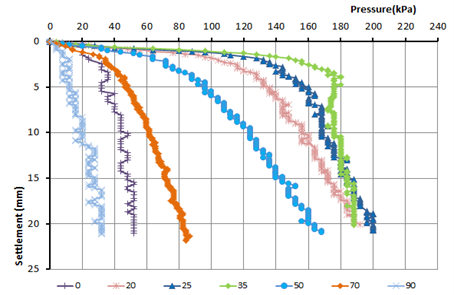
Figure 8. Load-Settlement Curves at Various Saturation Degrees (Palmyra Soil).
The bearing capacity of the tested soils was determined based on the results of loading tests conducted at varying degrees of saturation. The results are presented in Table 2.
Table 2. Ultimate bearing capacity for tested soils.

The results of the loading tests indicated that the bearing capacity of the soil increased with the increase in the degree of saturation, reaching a maximum value at a saturation degree of 35%. In particular, the bearing capacity of Tartous soil was determined to be ninefold greater than that of fully saturated soil, while the bearing capacity of Palmyra soil was found to be 9.7 times greater than that of fully saturated soil. Nevertheless, an increase in the degree of saturation beyond 35% resulted in a reduction in the bearing capacity of the soil. Figures 9 and 10 demonstrate the impact of varying degrees of saturation on the ultimate bearing capacity.

Figure 9. Variation of Ultimate Bearing Capacity with Saturation Degree (Tartous Soil).

Figure 10. Variation of Ultimate Bearing Capacity with Saturation Degree (Palmyra Soil).
The initial increase in ultimate bearing capacity with an increasing degree of saturation can be attributed to the expansion of the contact water-air interface and its contribution to the overall strength of the soil. The subsequent decline in bearing capacity with rising saturation is attributed to the rise in moisture content within the sample, which results in an expansion of pore filling with water. This, in turn, increases the radius of curvature of water between particles, reducing matric suction and consequently limiting its contribution to the augmentation of effective stress.
The vertical strain (bulging) of the soil was measured at a distance of 50 mm from the edge of the footing model. The following observations were made for Tartous soil, the values of vertical strain for tests at saturation degrees of 20%, 25%, 35% were greater than the vertical strain for tests at saturation degrees of 50%, 70%, 90%. In the case of the Palmyra soil, the value of the vertical strain for tests conducted at a saturation degree of 35% was found to be greater than that of the vertical strain for tests conducted at saturation degrees of 20%, 25%, 50%, 70% and 90%.
The extension of the sheared zone to the soil surface was observed at 20%, 25%, 35% saturation degrees for Tartous soil and at 35% saturation degrees for Palmyra soil. Furthermore, pressure-settlement curves (Figures 7 and 8) at these saturation degrees demonstrate a failure followed by a softening behaviour, which corroborates the hypothesis that the medium-dense soil fails under the general shear failure mode. This implies that the mode of failure, which is related to dense soils, may also occur in medium-dense soils at certain degrees of saturation. Figure 11 presents images of the results of bearing capacity tests conducted at specific saturation levels, wherein general shear failure was observed.
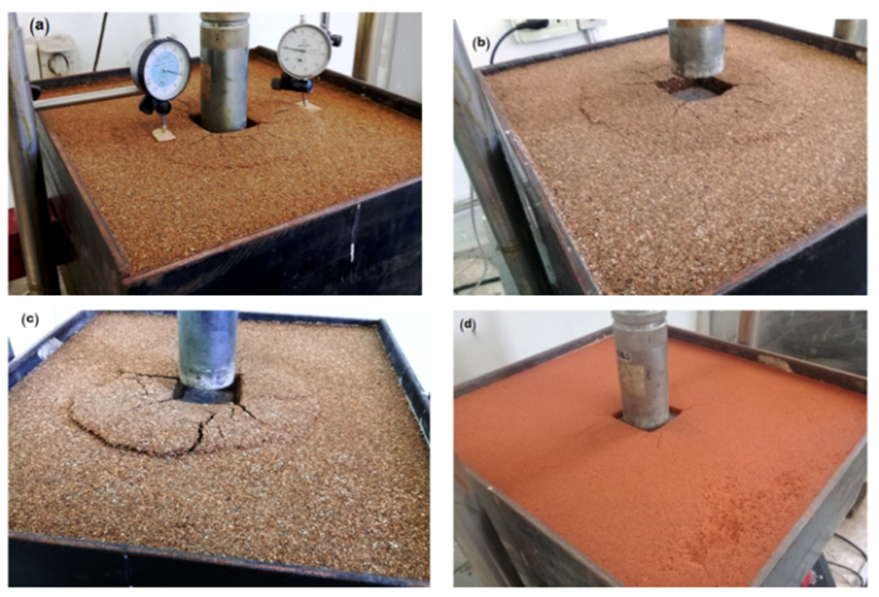
Figure 11. Images of The Bearing Capacity Test at Which General Shear Failure Occurred.
(a, b, c) for Tartous soil at 20%, 25%, 35% saturation degree respectively, (d) for Palmyra soil at 35% saturation degree.
Additionally, vertical strains were quantified at a distance of 80 mm from the edge of the footing model. It was observed that their values were nearly inconsequential (not exceeding 0.2 mm) for all tests. It can therefore be concluded that the dimensions of the proposed soil container may be reduced.
In light of the experimental findings, an empirical equation (5) was put forth as a means of predicting the bearing capacity of partially saturated sandy soils. The equation is dependent upon the bearing capacity under full saturation and the matric suction.
q = qu(sat) [-0.432(ua– uw )2 + 4.878(ua– uw) – 4.49] (5)
qu: Ultimate Bearing Capacity in the Case of Partial Saturation, qu(sat): Ultimate Bearing Capacity in the Case of full Saturation, ua-uw: Matric Suction.
A comparison was conducted between the experimentally determined values for bearing capacity and the values estimated from the proposed equation for different sizes of square footings atop poorly graded sandy soil as demonstrated in Table3. The results of these tests are presented in Figure 12, which demonstrates a high degree of correlation between the measured and predicted values.
Table 3. Details of Loading Tests for Footing Model.

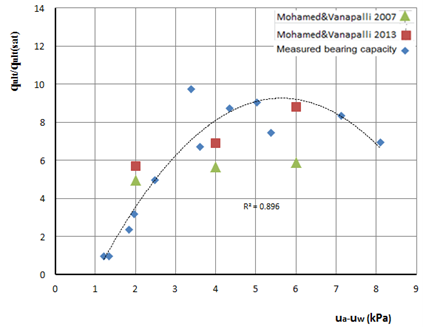
Figure 12. Variation of Partially Saturated Ultimate Bearing Capacity with Matric Suction.
The results of the loading tests demonstrated that the bearing capacity exhibited an increase with the rise in degree of saturation up to 40% (S < 40%), while a decline in bearing capacity was observed with the increase in saturation degree beyond 40% (S > 40%).
The test results demonstrated that the degree of saturation exerts an influence on the failure mechanism. The failure mode observed in medium-dense soils was found to be related to dense soils at specific degrees of saturation. Additionally, a transition from local to general shear failure was noted at a specific degree of saturation. In the case of the sandy soils that were subjected to testing, this transition was observed to occur at saturation degrees of between 20 and 35% for the Tartous soil and 35% for the Palmyra soil.
A predictive empirical equation was proposed to estimate the bearing capacity of tested sandy soils in partially saturated conditions, based on the bearing capacity in fully saturated conditions and the matric suction.
The experimental equation proposed in this research was derived from a limited number of experimental results on two types of sandy soil. It would be beneficial to conduct further research on other types of sandy soils in order to evaluate the proposed experimental relationship.
Cite: Khalil, S., Abboud, N., & Almoukdad, F. (2024). Studying Effect of Saturation Degree on the Bearing Capacity and Failure Mechanism of Sandy Soils. Steps For Civil, Constructions and Environmental Engineering, 2(1), 1–7. https://doi.org/10.61706/sccee120116
![]()
Copyright: © 2023 by the authors. Licensee Scientific Steps International Publishing Services, Dubai, UAE.
This article is an open access article distributed under the terms and conditions of the Creative Commons Attribution (CC BY) license (https://creativecommons.org/licenses/by/4.0/).






An independent academic publisher with an editorial team including many of the top researchers in the world. SSG publishes research, review, and case report articles in double-blind, peer-reviewed, open access scientific and academic journals.
Copyright © 2025 Scientific Steps International Publishing Services LLC (Dubai – United Arab Emirates)